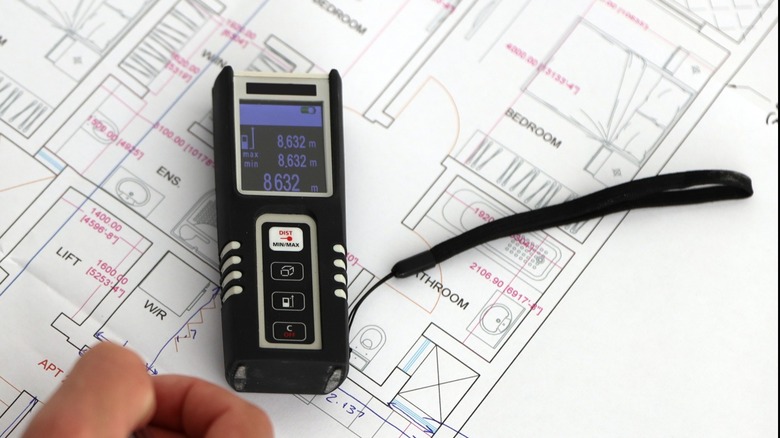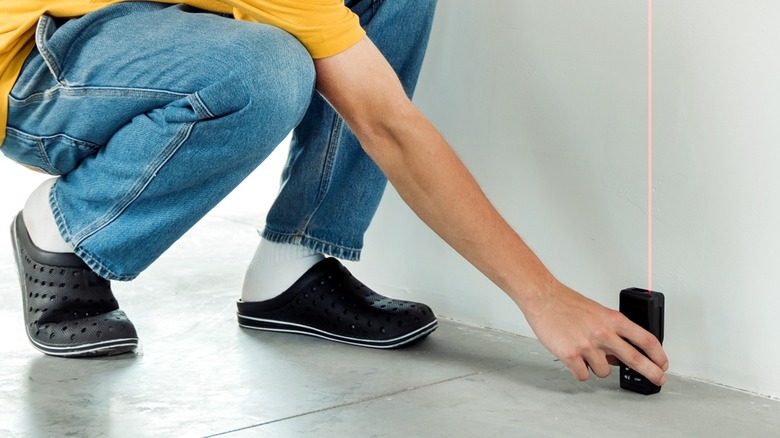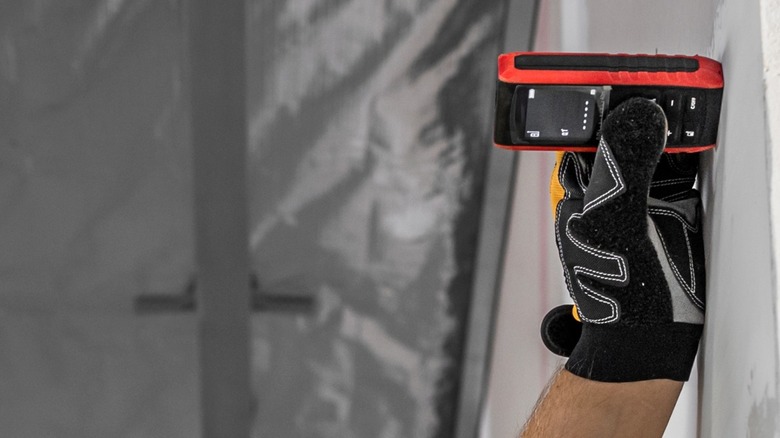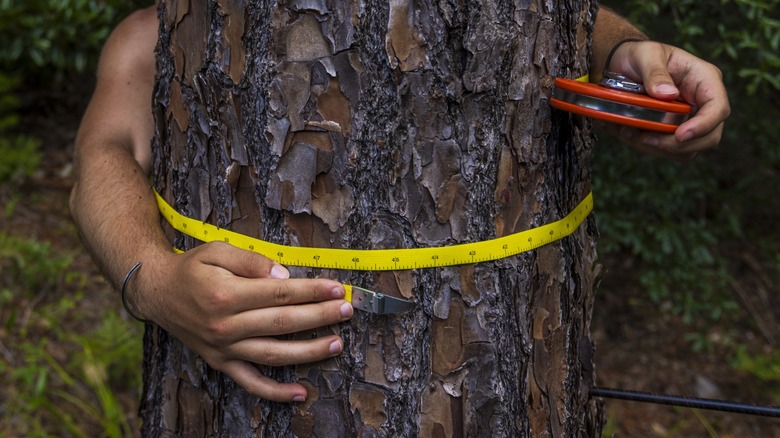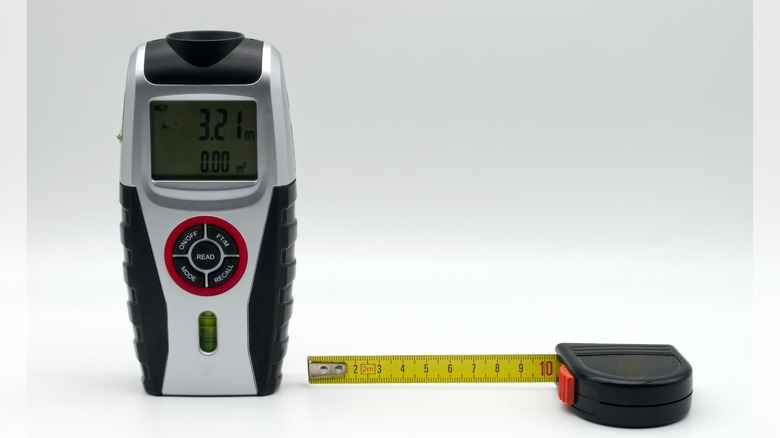Are Milwaukee Laser Distance Meters Worth The Investment For Home DIY Enthusiasts?
We may receive a commission on purchases made from links.
Measuring things is an essential part of building—whether you're a professional contractor or an occasional DIY-er, you must have a reliable measurement device to ensure you're getting the correct dimensions for whatever you're doing. After all, most experienced builders say that you should measure twice and cut once.
If you're in a pinch, you can use something like an Android measurement app to find what you need, but most people would say you need a nice measuring tape to find dimensions. After all, we've been using the measuring tape for almost two centuries now, so why would we need another tool? In fact, measuring tapes have a few hidden features that will make them far more useful and accurate in their designated tasks.
However, measuring tapes still have a few limitations. For example, you can only measure the length that's indicated on the tool; for example, my tape measure only has a 26-foot length, meaning it would be difficult for me to find distances longer than that. It's also quite bulky and heavy, so it's difficult to put in my pocket while I'm working.
On the other hand, professionals have been using lasers to measure distances for decades now. Leica Geosystems first introduced the laser distance meter in 1993, and now, more than three decades later, you can get a laser distance meter for personal use and not pay a fortune for it. I personally own a laser distance meter and have found it useful in the many projects that I've completed. In fact, I'm doing some home renovation work at the time of writing, which is why this tool is always on my desk or in my pocket.
What are laser distance meters?
Before figuring out if you need a laser distance meter, we must first define what is it. As the name suggests, a laser distance meter uses a laser pulse to find the distance from the tool to the surface that you're pointing at. Most laser distance meters first use a visible laser so you can easily target it to the correct surface you're measuring.
Once you're set, you can then press the measure button, and it will then fire a pulse of laser. The meter would then detect its reflection and then measure the time it took to see that from the initial burst of laser light. It then computes the distance by using the following formula: speed multiplied by time, then divided by two.
Given that the speed of light is mighty fast — about 300,000 kilometers per second — the laser distance meter must have a fairly precise timepiece within it to ensure accuracy. Thankfully, our technology has advanced to the point that even small, affordable devices can have that feature.
The advantages of laser distance meters
Laser distance meters have many big advantages over the traditional tape measure. First off, it's much faster at measuring distances. With a tape measure, you either have to hook one end of the tape measure to an edge or point and then pull it or slowly pull out the tape toward the side you want to measure. Before noting the number you see on the tool, you must ensure that it's carefully aligned and that there are no sags or bends along its length to avoid getting the wrong length.
But with a laser distance measure, you just point, press the button, and then look at the number on the screen. This means that it's also much easier to use. You don't need a companion to help you, even if you're measuring an uneven edge or a surface that has no place to hold the tip of the tape measure. Since most laser distance meters also have built-in memory, you don't need to write or note the numbers that you measure immediately. You can just finish all your measurements in one go and then go through the device's memory after doing all the labor.
Furthermore, laser distance meters are much smaller and lighter than an equivalent tape measure. For example, my tape measure can only go as far as 26 feet, but my laser distance measure, which weighs just a quarter of the tape measure, can go as far as 65 feet.
When I was planning my current home renovation, I spent less than 10 minutes finding the dimensions of the more than 11 areas of my house all by myself. This would've probably taken 45 minutes and two people with my measuring tape.
What laser distance meters cannot do
Despite all the pros of laser distance meters, they also have a few limitations. Because light is so fast and the clocks inside most laser distance meters have limited precision and accuracy, they cannot measure small distances. My laser tool runs into an error if I measure distances smaller than 6 cm or 2.35 inches.
You also have to ensure that there's a flat surface that will reflect the laser pulse to get the measurement you need. I've already had several occasions where I had to place a piece of wood or cardboard to mark the point I wanted to measure. That way, the laser measurement tooI will have a surface that can reflect the laser pulse that it emits.
It also doesn't work on surfaces that are too reflective or absorb light completely. When I tried measuring the distance from a wall to a window, the laser distance meter simply returned an error because the laser pulse just went through the glass.
Aside from that, laser distance meters are electronic devices, so you need batteries to use them. The tool that I have is powered by two AAA-size batteries, and I always bring a backup set to ensure that I do not run out of power while using it. On the other hand, you do not need any kind of power source to use a tape measure.
What do Milwaukee laser distance meters offer?
Since laser measurement technology is so old, you could find laser distance meters from just about any source. However, if you're looking for something that will last you a lifetime, consider going with a known and reputable brand like Milwaukee.
Milwaukee Laser Distance Meters aren't the best budget-friendly tools you can find in Home Depot, but I would say that they come in pretty close. The tool maker offers three different ranges for its Laser Distance Meter in Home Depot— 65 feet ($59.97), 150 feet ($104.97), and 330 feet ($219.00).
The 65-foot model only offers basic measurement, memory for three readings, and a backlit screen. The more expensive 150-foot model adds a color screen, memory for 30 readings, and an auto-detecting lever to help you easily measure from corners. It also adds a simple computer that will let you add and subtract numbers, as well as calculate distance, surface area, total area, and volume.
Now, if you're a pro or have more complicated projects, the 330-foot model adds a digital auto-level, helping to ensure that your meter is at a level position before taking a reading. It also has a more advanced built-in computer that will compute indirect measurements, allowing you to find the distances between points just by pointing at them from a fixed location.
Do you need a laser distance meter for your DIY projects?
So, now that you know what a laser distance meter can do, do you need one for your DIY project? I personally find my own laser tool convenient, as it helps me save time for measuring things. However, you should note that my projects are big — often at least the size of a piece of furniture or room.
For smaller projects, I really don't use my laser measurement tool as it's quite impractical. A ruler would suffice for those instances, and it's much easier to just place it thing that I'm measuring on a desk and place a 6-inch ruler on it to find its dimensions.
Here's my rule of thumb when recommending a laser distance meter: if you find yourself frequently measuring spaces for your projects, then you're going to love this laser tool. It will make it easier and faster to find large dimensions with greater accuracy. It also goes beyond creating things—it's also great for planning spaces.
Alternatives to the Milwaukee laser distance meter
While the Milwaukee Laser Distance Meter is a great option if you want a laser measuring tool, there are other great brands out there that offer the same functionality for a lower price. For example, this Bosch Laser Distance Measure with a 100-foot range only costs $48.94 on Amazon, saving you over $10. It's also #1 Top Rated on the eCommerce platform with a 4.7 rating over 16,250 reviews.
If you're looking for something cheaper, you could opt for the Kiprim Laser Distance Measure. It has a 165-foot range and is only priced at $16.99 at the time of writing, with a regular price of $19.98 on Amazon. Even though it's not from a popular brand like Bosch, it still has a 4.3 rating over 5,782 reviews, which seems like a good enough record. This would likely be good enough if you only plan on using it occasionally.
But if you don't like bringing around two different measuring tools, the Lexivon 2-in-1 Digital Laser Tape Measure will give you the best of both worlds. It's on sale at Amazon for $49.96, with a regular price of $83.28, and has a 4.4 rating across 6,961 reviews. This tool gives you a tape measure for when it's difficult or inconvenient to use a laser measuring device, but you also don't need to carry a different tool for making laser measurements. It might not have the advanced options that the more expensive Milwaukee laser distance meters offer, but if your DIY projects are few and far between, then you might this combined tool more useful than having just one or the other.
